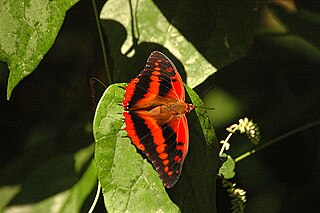
Hyarotis microstictum, the brush flitter, is a butterfly belonging to the family Hesperiidae. It is found in the Indomalayan realm and in South India. H. m. coorga Evans, 1949 is the subspecies found in South India. H. m. microstictum is the subspecies found in the Indomalayan realm.

Papilio crino, the common banded peacock, is a species of swallowtail (Papilionidae) butterfly found in parts of the Indian subcontinent, including India, Nepal, Bhutan and Sri Lanka.

Papilio castor, the common raven, is a species of swallowtail butterfly found in Cambodia and South Asia.

Papilio elephenor, the yellow-crested spangle, is a species of swallowtail butterfly found in Northeast India. Following decades without confirmed sightings, it was rediscovered in 2009 in Assam.

The Indian fritillary is a species of butterfly of the nymphalid or brush-footed family. It is usually found from south and southeast Asia to Australia.

Ancema blanka, the silver royal, is a species of lycaenid or blue butterfly found in the Indomalayan realm. The species was first described by Lionel de Nicéville in 1894.

Aslauga is a genus of butterflies in the family Lycaenidae. They are associated with other insects and found only in the Afrotropical realm. They are small usually grey-blue or grey-purple butterflies with a distinctive, but widely varied wing shape, especially pronounced in A. pandora. They are forest butterflies of the Congolian forests and Lower Guinean forests.

Papilio morondavana, the Madagascan emperor swallowtail, is a species of butterfly in the family Papilionidae. It is endemic to Madagascar. The habitat consists of forests.

Surendra vivarna, the acacia blue, is a species of lycaenid or hairstreak butterfly found in Sri Lanka, India and the Indonesian islands as far as Sulawesi.

Papilio ambrax, the Ambrax butterfly, is a butterfly of the family Papilionidae. It is found in Queensland, Australia, as well as the Aru Islands, Papua (Indonesia), and Papua New Guinea.

Papilio iswara, the great Helen, is a species of large swallowtail butterfly found in parts of Southeast Asia.

Papilio diophantus is a species of swallowtail butterfly from the genus Papilio that is found in Sumatra.

Papilio erithonioides is a species of swallowtail butterfly from the genus Papilio that is found in Madagascar. The habitat consists of forests.

Papilio iswaroides is a species of swallowtail butterfly from the genus Papilio that is found in Malaysia and Sumatra. It was first described by German entomologist Hans Fruhstorfer in 1898.

Pseudohaetera hypaesia, the hypaesia satyr, is a butterfly species from the subfamily Satyrinae in the family Nymphalidae.

Charaxes cynthia, the western red charaxes, is a butterfly in the family Nymphalidae. It is found in Senegal, Guinea, Sierra Leone, Liberia, Ivory Coast, Ghana, Nigeria, Cameroon, Gabon, the Republic of the Congo, the Central African Republic, the Democratic Republic of the Congo, Uganda, Angola, Sudan, Uganda, Kenya, Tanzania and Zambia.

Charaxes phoebus is a butterfly in the family Nymphalidae. It is found in Ethiopia. The habitat consists of montane forests and woodland.

Parides mithras is a species of butterfly in the family Papilionidae. It is found in Venezuela, Guyana, French Guiana and Brazil (Amazonas).

Parides aglaope is a species of butterfly in the family Papilionidae. It is found in Brazil and Bolivia.

Arhopala antharita is a butterfly in the family Lycaenidae. It was described by Henley Grose-Smith in 1894. It is found in New Guinea.



















